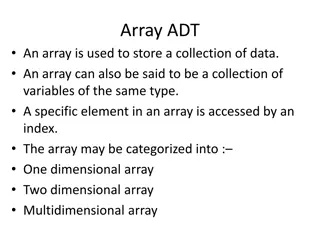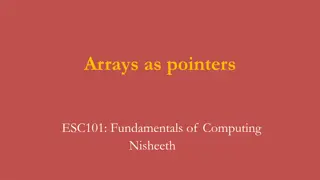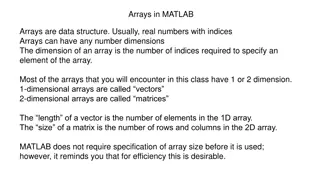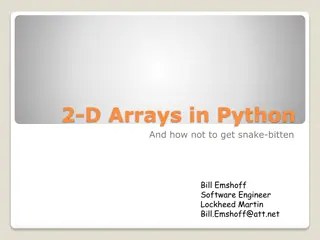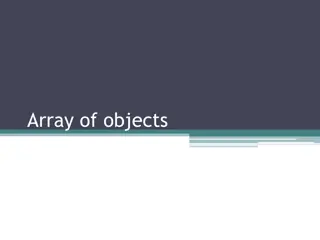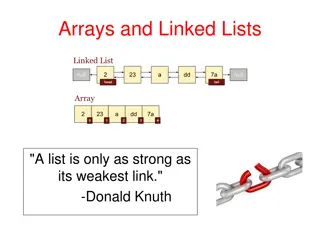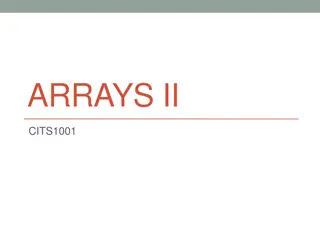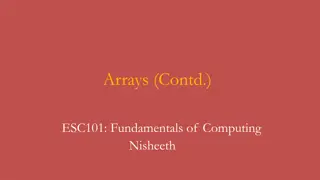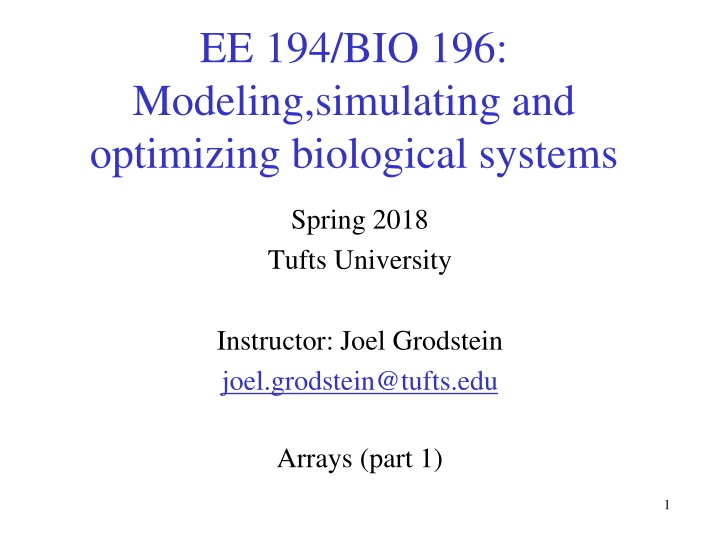
Arrays: Modeling and Optimizing Biological Systems
Explore the concept of arrays in the context of modeling and optimizing biological systems. Learn how arrays can help organize and manipulate data efficiently, illustrated with examples from a class on biological systems. Discover the benefits of using arrays for managing and processing large sets of data.
Uploaded on | 0 Views
Download Presentation

Please find below an Image/Link to download the presentation.
The content on the website is provided AS IS for your information and personal use only. It may not be sold, licensed, or shared on other websites without obtaining consent from the author. If you encounter any issues during the download, it is possible that the publisher has removed the file from their server.
You are allowed to download the files provided on this website for personal or commercial use, subject to the condition that they are used lawfully. All files are the property of their respective owners.
The content on the website is provided AS IS for your information and personal use only. It may not be sold, licensed, or shared on other websites without obtaining consent from the author.
E N D
Presentation Transcript
EE 194/BIO 196: Modeling,simulating and optimizing biological systems Spring 2018 Tufts University Instructor: Joel Grodstein joel.grodstein@tufts.edu Arrays (part 1) 1
What is a an array An array is an ordered, indexed group of variables that share the same name. It's like a variable, but with a bunch of buckets in a row that are all numbered. Demo with using a 1D egg carton and eggs to represent an array. EE 194/Bio 196 Joel Grodstein 2
What is a an array The name of the variable Arrays are in the numpy package. We ll talk about packages more in the functions lecture Example: import numpy as np arr1 = np.array ([1, 3, 7]) Our variable arr1 has three little buckets in it We can access each bucket individually: arr1[0] is 1; arr1[1] is 3; arr1[2] is 7. 1 3 7 arr1[0] arr1[1] arr1[2] EE 194/Bio 196 Joel Grodstein 3
What is an array Terminology: the individual elements of the array are called, well, elements Our arr1 has 3 elements. Later on we ll do 2-dimensional arrays 1 3 7 arr1[0] arr1[1] arr1[2] EE 194/Bio 196 Joel Grodstein 4
So what? An array lets you collect a bunch of similar things, refer to them by one name, and operate on all of them at once. Consider the grades of a 4-student class for HW1: HW1_a=90 HW1_b=99 HW1_c=60 HW1_d=90 HW1=np.array([90,99,60,90]) Which format would you rather work with? What if there were 100 students rather than 4? EE 194/Bio 196 Joel Grodstein 5
But wait, theres more Consider the same deal for HW2: HW2_a=91 HW2_b=80 HW2_c=55 HW2_d=93 HW2 = np.array([91,80,55,93]) What if you want each student s average? avg_a=(HW1_a+HW2_a)/2 avg_b=(HW1_b+HW2_b)/2 avg_c=(HW1_c+HW2_c)/2 avg_d=(HW1_d+HW2_d)/2 avg=(HW1+HW2)/2 Works no matter how many students there are! Yes it does! EE 194/Bio 196 Joel Grodstein 6
Reading and writing array elements HW1=np.array([90,99,60,90]) print (HW1) HW1[2] HW1[2]=99 print (HW1) [90,99,60,90] 60 [90,99,99,90] EE 194/Bio 196 Joel Grodstein 7
array-scalar operations arr1=np.array([1.0, 3.0, 7.0, 5.0]) arr1 = arr1 * 1.1 Perhaps we re storing how much money everyone has, and they all got 10% interest. What do you think this would do? arr2 = arr1 + 1.1 arr2=[2.2, 4.4, 8.8, 6.6] Now arr1=[1.1, 3.3, 7.7, 5.5] Why might we do this? EE 194/Bio 196 Joel Grodstein 8
array-array operations arr1=np.array([1, 3, 7, 5]) arr2=np.array([2, 2, 1, 1]) What do you think these would do? arr3 = arr1 + arr2 arr3 = arr1 * arr2 arr3=[3, 5, 8, 6] [2, 6, 7, 5] EE 194/Bio 196 Joel Grodstein 9
Dot product Arrays support a dot product operation arr1=np.array ([1, 3, 7, 5]) arr2=np.array ([2, 2, 1, 3]) x = arr1.dot(arr2) = (1*2) + (3*2) + (7*1) + (5*3) = 2 + 6 + 7 + 15 = 30 How about x = arr2.dot(arr1)? = (2*1) + (2*3) + (1*7) + (3*5) = 2 + 6 + 7 + 15 = 30 Will arr1.dot(arr2) and arr2.dot(arr1) always give the same answer? Yes, because multiplication is commutative Why do I care about dot products? They re extremely useful in linear algebra They also help in population modeling as we will soon see EE 194/Bio 196 Joel Grodstein 10
Where else might arrays be useful? Any other ideas where arrays might be useful? Height of 100 patients (or weight) Temperature of each day of the year Really, most any time you want to keep track of a big bunch of items EE 194/Bio 196 Joel Grodstein 11
Other ways to make an array np.array ([1,3,7]) np.zeros (5) np.ones(3) np.array(range(6)) [1,3,7] as we ve already seen [0,0,0,0,0] i.e., 5 zeros [1,1,1] i.e., 3 ones [0,1,2,3,4,5] just like for EE 194/Bio 196 Joel Grodstein 12
Getting information about an array a1=np.array ([1,3,7]) a2=np.zeros (5) a1.size a2.size 3 (because a1 has 3 elements) 5 (because a2 has 5 elements) EE 194/Bio 196 Joel Grodstein 13
sum() and its friends a1=np.array ([1,3,7]) a2=np.zeros (5) a1.sum() a1.prod() a2.prod() a1.min() a1.max() 11 (i.e., 1+3+7) 21 (i.e., 1*3*7) 0 (i.e., 0*0*0*0*0) 1 (i.e., the smallest number of 1, 3 and7) 7 (i.e., the largest number of 1, 3 and7) EE 194/Bio 196 Joel Grodstein 14
Slices Array slices let us refer to a piece of an array, just as if it were an entire array. a1=np.array ([1,3,5,7,9]) a1[1:3] a1[2:5] a1[2:5].sum() a2 = np.array ([2,3,4]) a1 + a2 a1[1:4]+a2 a1[1:4].dot(a2) [3,5] [5,7,9] 5+7+9=21 (remember this for later ) Illegal; a1 has 5 elements & a2 has 3 [5,8,11] 3*2 + 5*3 + 7*4 =49 EE 194/Bio 196 Joel Grodstein 15
Inconsistent syntax Note the similar (but not quite identical) syntax for i in range (1,9,2): i becomes 1, 3, 5 and 7 Accesses the array slice with elements a[1], a[3], a[5] and a[7] a1[1:9:2] Why does Python use , for the range and : for arrays? Well, it just does. Who ever really knows why? range() is a function, so it uses , to separate its arguments Using , for arrays wouldn t work for multi-dimensional arrays EE 194/Bio 196 Joel Grodstein 16
Writing slices You can write into slices, too a=np.array ([1,3,5,7,9]) a[1:4]=[10,11,12] Now a is [1,10,11,12,9] error; cannot assign a[1:4] with just 2 elements a[1:4]=[10,11] a[1:4] = 5 this actually works. Python figures out what you really mean; it assigns 5 to all 3 elements of a[1:4]. And it could be useful on HW2 EE 194/Bio 196 Joel Grodstein 17
More slices a=np.array ([1,3,5,7,9]) a[-1] a[-3] a[4:0:-1] a[-1:0:-1] But how do you get [9,7,5,3,1]? Leave it as a challenge 9 (counts from the end) 5 [9,7,5,3] trick: a has 5 elements, and 5- 1=4, so use a[4] [9,7,5,3] EE 194/Bio 196 Joel Grodstein 18
for loops and arrays a1=np.array ([1,3,7]) for data in a1: print (data) 1 3 7 And of course, slices work as usual for data in a1[1:3]: print (data) 3 7 In fact, this works too for data in [1,3,7]: print (data) 1 3 7 EE 194/Bio 196 Joel Grodstein 19
Pitfall #1: arrays have a type a=np.array ([1,3,5]) a[1]=4.1 a [1,3,4] What happened? a is an array of integers, not an array of real numbers It cannot hold 4.1, so 4.1 gets truncated to 4. Python is not like Matlab in this regard a = np.array ([1.0, 3.0, 5.0]) a[1]=4.1 print(a) [1,3,4.1] Now it s an array of real numbers (i.e., float )! In fact, all numbers are either integers or floating point; we just never had to deal with it until now EE 194/Bio 196 Joel Grodstein 20
Pitfall #1: arrays have a type a=np.array ([1,3,5]) a=np.array ([1.0,3.0,5.0]) a=np.array ([1,3,5.0]) all elements of an array will have the same type 5.0 is a float, so everything else becomes one too a=np.array ([1,3,5],dtype=float) a.dtype a=np.array ([1,3,5]) a.dtype array of integers array of float array of float array of float float64 int64 EE 194/Bio 196 Joel Grodstein 21
Pitfall #2: Arrays are weird a1 = np.array ([2,4,6]) a2 = a1 print (a1) print (a2) a2[1]=1 print (a2) print (a1) Now a2=[2, 4, 6] [2, 4, 6] [2, 4, 6] [2, 1, 6] [2, 1, 6]. What happened???!! EE 194/Bio 196 Joel Grodstein 22
Explain this Do a demo with cups and egg cartons. A carton cannot fit in a cup, so we use a pointer instead And a2=a1 does not make a new egg carton; just adds a string to the same one. EE 194/Bio 196 Joel Grodstein 23
Beating pitfall #2 a1 = np.array ([2,4,6]) a2 = a1 a2[1]=1 print (a2) print (a1) [2, 4, 6] Now a2=[2, 4, 6] [2, 1, 6] [2, 1, 6] Now we have two different egg cartons a1 = np.array ([2,4,6]) a2 = np.array ([2,4,6]) a2[1]=1 print (a2) print (a1) [2, 1, 6] [2, 4, 6] We ll learn more strategies to beat this problem later EE 194/Bio 196 Joel Grodstein 24
Follow the bouncing ball a1 = np.array ([2,4,6]) a2 = a1 a2[1]=1 a1 = np.array ([2,4,6]) a2 = np.array ([2,4,6]) a2[1]=1 U U a2 a1 1 2 4 6 2 4 6 1 2 4 6 EE 194/Bio 196 Joel Grodstein 25
Do slices have the same issue? a1 = np.array ([2,4,6,8,9]) a2 = a1[1:3] a1[1]=1 print (a2) What happens? EE 194/Bio 196 Joel Grodstein 26
Group exercise Remember lx-mx and new births? n1,n+1 = n0,n * p0 n2,n+1 = n1,n * p1 n3,n+1 = n2,n * p2 n0,n+1= (n1,n+1* m1)+(n2,n+1* m2)+ (n3,n+1 * m3) Can we use arrays for this? n = np.array ([n0, n1, n2, n3]) p = np.array ([p0, p1, p2, p3]) How do we make an array n_next? Hint: use slices and dot products EE 194/Bio 196 Joel Grodstein 27
Advanced indexing See https://docs.scipy.org/doc/numpy- 1.13.0/user/basics.indexing.html for documentation Arrays and Booleans In addition to integers and floats, Python also has Boolean: either True or False ar=np.array ([1,3,5,9,4]) ar>4 ar[ar>4] ar[ar>4] = 10 np.all (ar>4) np.any (ar>4) Note that this is quite similar to Matlab EE 194/Bio 196 Joel Grodstein 28
Advanced indexing You can index an array with another array. What do these all do? ar=np.array ([1,3,5,9,4]) ar [ np.array([2,2,1]) ] ar [ np.array([2,2,1]) ] += 1 np.flatnonzero (ar>4) ar2 = np.array ([10,20,30,40,50,60]) ar2 [ np.flatnonzero (ar>4) ] = 100 ar3 = np.array ([10,20,30,40,50,60]) ar3 [ 1+np.flatnonzero (ar>4) ] = 100 EE 194/Bio 196 Joel Grodstein 29
Advanced indexing Is advanced indexing weird? I.e., does advanced indexing copy by reference? What does this code do? ar=np.array ([1,3,5,9,4]) ar2 = ar [ np.array([2,1]) ] ar[1] = 10 print (ar2) EE 194/Bio 196 Joel Grodstein 30
A few more group exercises Print an array backwards (so if ar=[1,3,7] then print [7,3,1]) You can do it with a for loop You can also do it in one statement with slices (but there s a trick that we haven t learned yet) This will be useful for the Manduca HW Take an array p. Multiply every element by a random number r, and then bound them all to be 0 and 1. You may want to Google numpy clip This will be useful for HW3 EE 194/Bio 196 Joel Grodstein 31
Follow-up activities Try the examples from this lecture yourself Vary them, or even mis-type some to see what happens More exercises. Write a program that determines the largest and smallest numbers from an array creates a 5-element histogram from a given array of integers. So if ar=[1,4,1] then it creates an array hist=[0,2,0,0,1]. creates an array of 10 zeros, and update sixth value to 11 Use advanced indexing (if you choose) to print all elements in an array that are even multiply all odd numbers in an array by 10. reverse the order of all even numbers in an array, so that [0,1,3,4,5] becomes [4,1,3,0,5] You can do all of these in one line of code EE 194/Bio 196 Joel Grodstein 32
Random numbers We ve talked about stochastic models. How do you get random numbers in Python? random.randrange(0,10) Returns a random integer 0 and <10 exact same syntax as range() 5 2 8 5 1 import random for i in range(3): print (random.randrange(0,10)) Observations? Yes, the numbers seem pretty random No reason you can t get the same number twice in a row Every time you run the program, you potentially get a different sequence 0 9 3 1 EE 194/Bio 196 Joel Grodstein 33
Random repeatability Random behavior can be really hard to debug Consider the following program to print small fractions in decimal form import random num = (random.randrange(0,10)) den = (random.randrange(0,10)) print (num / den) Any obvious bugs? Let s run it a few times .2 3 What combination of numbers could have given .2? 1 / 5 (not 2 / 10) print (num/den) ZeroDivisionError: division by zero Traceback (most recent call last): File "Q:/test.py", line 4, in <module> It s hard to debug this issue, if we can never predict when it will occur EE 194/Bio 196 Joel Grodstein 34
Seeding Random-number generators can be seeded. If you plant tomato seeds tomatoes will grow import random random.seed(5) for i in range(3): print (random.randrange(0,10)) 3 6 6 9 Now we get the same sequence every time sequence (which, again, is the same every time we run the program) 5 8 A different seed gives us a different (1) EE 194/Bio 196 Joel Grodstein 35
Seeding and debugging Still doesn t quite solve our problem import random random.seed(5) num = (random.randrange(0,10)) den = (random.randrange(0,10)) print (num / den) Ideas? Keep changing the 5 to other numbers and re-running; eventually it will fail repeatably Run over and over get 0.5 every time. It never breaks! 0.5 1 0.625 2 1.0 3 0.8888888888888888 9 0.8333333333333334 10 2.25 Traceback print (i, num/den) ZeroDivisionError: division by zero import random for i in range(1,20): random.seed(i) num = (random.randrange(0,10)) den = (random.randrange(0,10)) print (i, num / den) EE 194/Bio 196 Joel Grodstein 36
Normal distribution Normal distribution (a.k.a., Gaussian or bell- shaped curve) used quite commonly in biology, of course Python can draw numbers from it: rnd = random.gauss (mean, sigma) Everything we already said about seeds still applies EE 194/Bio 196 Joel Grodstein 37
Quantization How do you round off numbers in Python? round(4.3) round(4.7) ar = numpy.array ([4.3, 4.7]) round (ar) numpy.round (ar) % 4.0 % 5.0 % error % [4.0, 5.0] You can also round to nearest 0.1, .01, etc. EE 194/Bio 196 Joel Grodstein 38

